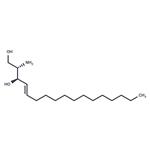Sphingosine is an amino alcohol most commonly characterized by an 18-carbon unsaturated hydrocarbon chain sphingosine (d18:1) . However, the hydrocarbon chain length of sphingosine, and the related dihydrosphingosine, can vary from 12-26 carbons in mammalian tissues. Sphingosine (d17:1) is a naturally-occurring but uncommon form of sphingosine, accounting for approximately 13% of the sphingosine in human skin. It can be phosphorylated by sphingosine kinases to produce C-17 sphingosine-1-phosphate. More commonly, sphingosine C-17 is used as an internal standard in the analysis of sphingoid compounds by chromatographic or spectrometric methods.
D-erythro-Sphingosine-C17 is a substrate for sphingosine kinase.
Sphingosine (d17:1) has been used as a lipid standard in the analysis of sphingolipids by liquid chromatography-mass spectrometry (LC-MS) and tandem mass spectrometry.
ChEBI: C17 sphingosine is a sphingoid that is the C17 analogue of sphingosine. It is an aminodiol and a sphingoid. It is a conjugate base of a C17 sphingosine(1+).
Sphingosine (d17:1) or D-erythro-sphingosine is a 17-carbon sphingolipid, found in human skin. It has one carbon less than naturally occurring C18-sphingosine.
Sphingosine acts a precursor for sphingosine-1-phosphate (S1P). Sphingosine C-17 is used as an internal standard in the analysis of sphingolipids by spectrometric methods.

